Kiállítás a Wellington Coffee & Pie kávézóban
Exhibition at Wellington Coffee & Pie
A Déri Múzeum megújult helytörténeti kiállítása, a Cívisek világa új megközelítésben mutatja be Debrecen és lakóinak történetét, sajátos világát, az első régészeti leletektől és írásos forrásoktól kezdve a polgárosodás megjelenéséig, a 19–20. század fordulójáig. Számos anyag és történet azonban nem kaphatott helyet a tárlatban, így nagy örömünkre szolgál, hogy ezek kis hányadát egy rendhagyó, de autentikus, történelmi helyszínen bemutathatjuk.
A tablókiállítás az egykor Piac utca 39. szám alatt álló Rickl-ház és kereskedés, a Török Császárhoz c. üzlet történetét mutatja be, amely csaknem 130 évig meghatározó pontja volt Debrecennek. Napjainkban helyén egy kedvelt, hangulatos kávézó, a Wellington & Pie működik, mely berendezésével – és most már a kiállítással is – megidézi az egykori bolt szellemét.
The World of the Cívis, the renewed local history exhibition in Déri Museum, sheds new light on the history of Debrecen, its particular customs and inhabitants, presenting a rich source of archaeological finds and archival materials from the first traces of civilisation in the area, through the time of the emerging middle classes to the modern era of the fin de siècle. Such an exhibition is always a curated selection of an abundance of materials, leaving exciting finds in storage for the lack of space. That is why we are delighted to present a satellite exhibit outside the museum, in an unusual but all the more authentic location: the Rickl House, right in the middle of Debrecen’s historical high street.
Facsimile documents, contemporary photographs and family portraits give us a glimpse into the life of the Rickl family, generations of merchants and wholesalers who operated a colonial goods, spice and general store, addressed to The Emperor of Turkey, at 39 Piac utca (Market Street) for almost 130 years. After decades of stormy history and changing businesses, the former shop has been refitted to a layout close to the original, now home to a popular, cosy café, Wellington Coffee & Pie. The décor and the small exhibition in the gateway and inside the café evoke the spirit of the once prosperous enterprise of the industrious Rickl family.
Isten hozott, jó helyen jársz!
E házban működött a 18. század végétől a 20. század elejéig a német származású Rickl család fűszer- és gyarmatáru-kereskedése. A Török császárhoz címzett üzletben egzotikus áruk mellett festéket és terményeket is árultak.
Számtalan anekdota és érdekesség fűződik a házhoz és a tágas emeleti lakásban élő gazdag kalmárcsaládhoz. Csak találgatni lehet, hogy valóban kardot cserélt-e a hadba vonuló Petőfivel az egyik Rickl fiú, vagy hogy a kereskedő inasok tényleg a mennyezetről függő kitömött cápa szájában tartották-e fontos irataikat. Az viszont tény, ennek a háznak a kertjében vetettek először burgonyát, és az egyik első utcai lámpás ezen az utcai homlokzaton gyúlt ki Debrecenben.
További érdekességek derülnek ki a Rickl családról és az üzletről a Déri Múzeum Cívisek világa helytörténeti kiállításán és Helyi érték várostörténeti fórumán.
Welcome, you are in the right place!
From the end of the 18th century to the beginning of the 20th century, this house was the spice and colonial goods trading house of the Rickl family who were of German origin. The shop, addressed to the Turkish emperor, sold exotic goods as well as paint and agricultural commodities. There are countless anecdotes and curiosities associated with the house and the wealthy merchant family in the spacious upstairs apartment.
We can only speculate whether one of the Rickl boys really exchanged swords with Petőfi, who was off to war, or whether the merchant apprentices really kept their important documents in the mouth of a stuffed shark hanging from the ceiling. But it is a fact that potatoes were first sown in the garden of this house, and one of the first street lamps in Debrecen was lit on this very façade.
Find out more about the Rickl family and the business at the Déri Museum’s The World of Cívis local historical exhibition and the Local Value urban historical forum.


KÜLSŐ TABLÓ
EXTERNAL TABLEAU
„Ebből az időből fennmaradt Zelmosról, hogy amikor először járt Debrecenben, a debreceni Fő-utcán, az úgynevezett Piac-utcán kilépte a várost és a város, illetve a Fő-utca közepe táján, az árnyékos oldalon ekkor nyitotta meg üzletét. Ugyanott vásárolta első házát.”
Móricz Pál: Magyar sirató. Feljegyzések, történetek a régi magyar életből. Szerző saját kiadása, Tahitótfalusi Sylvester nyomdai műintézet nyomásában, é.n. 9.
“It remains from this time that when Zelmos first visited Debrecen, the so-called Piac Street, the main street of Debrecen, he sized up the city and opened his shop in the middle of the main street, on the shady side. He also bought his first house there.”
Pál Móricz: Hungarian lament. Records, stories from the old Hungarian life. The author’s own edition, printed by the Sylvester Tahitótfalusi printing house, n.d. 9.
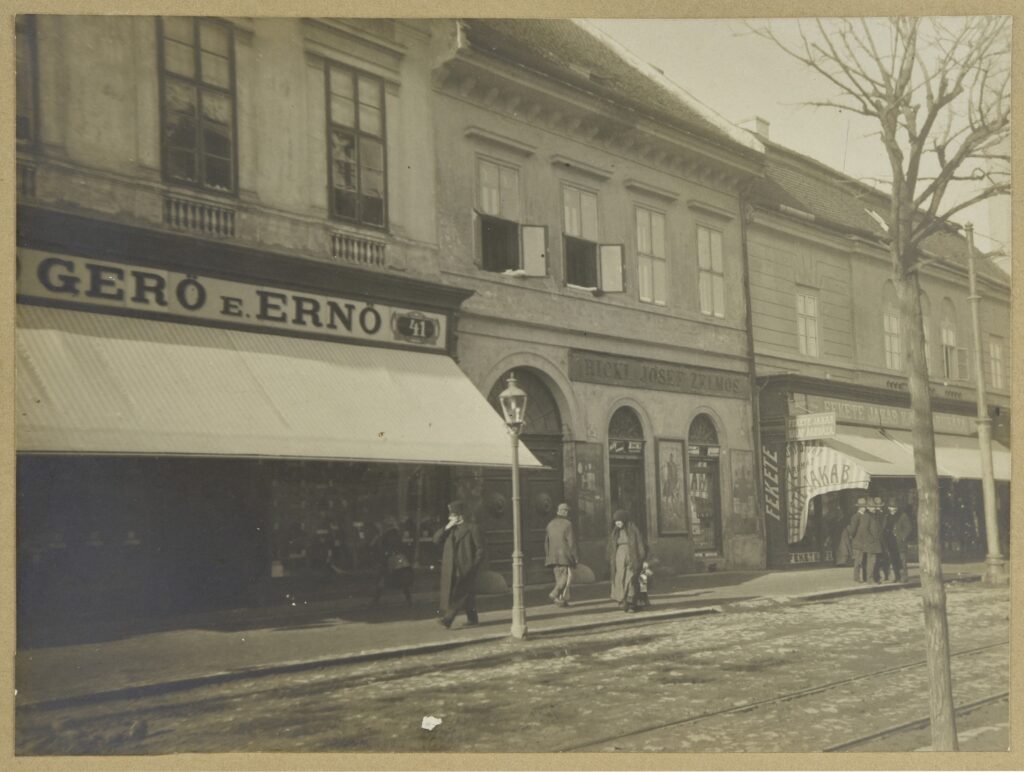
The grocery shop of József Rickl Zelmos called To the Emperor of Turkey in the Rickl House on Piac Street (next to the men’s clothing shop owned by Ernő E. Gerő and the hat shop of Jakab Fekete)
Ismeretlen fényképész, 1911.
Unknown photographer, 1911.

Part of the Piac street with the Rickl house, from the opposite side
Gerő László, 1951.
László Gerő, 1951.
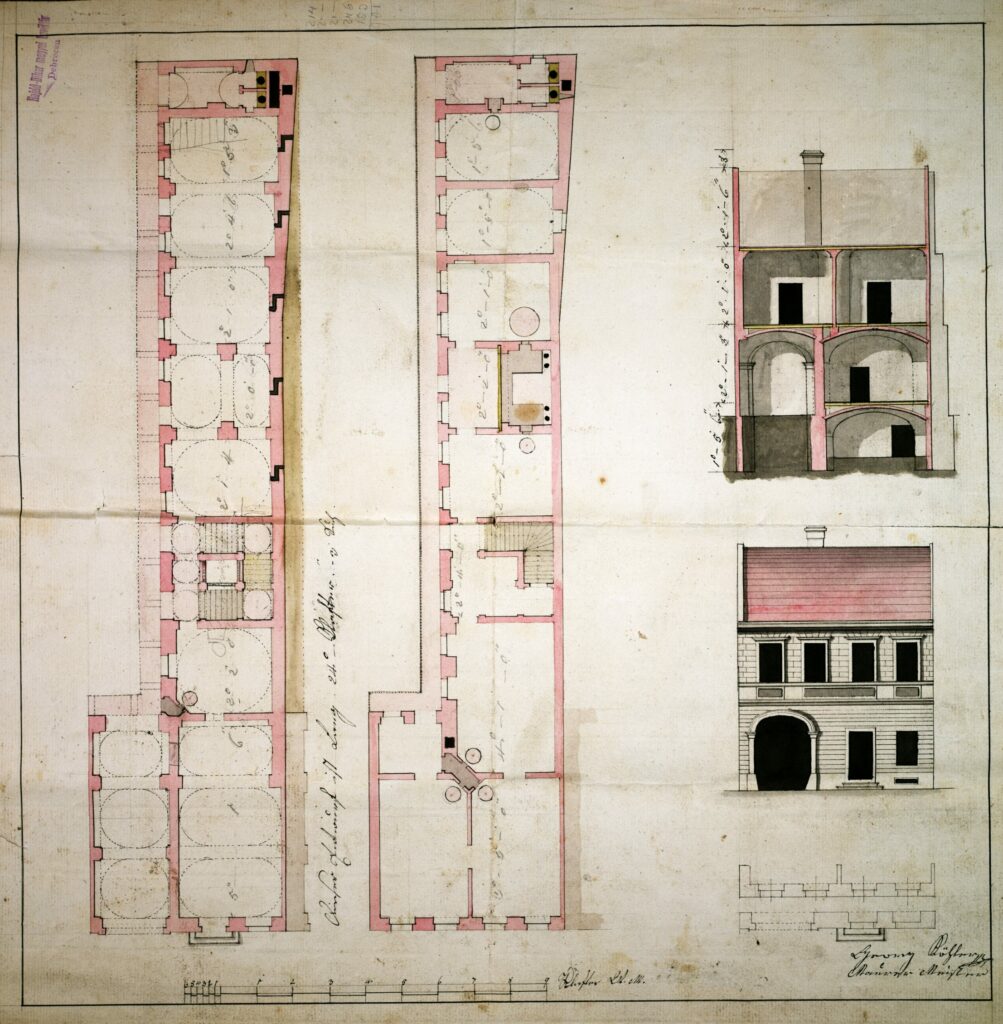
Blueprints of the Rickl House, 1820s
Forrás: HU MNL HBVL XV 1b dvt-1034 ad
Source: HU MNL HBVL XV 1b dvt-1034 ad
„… csengős lovakon, a körülszáguldozó lovaslegényektől kisérgetve a város nem közönséges látványosságára, úgy szállottak be a Kistemplom mellé, a keskeny, hosszú, kettős várudvarú öreg kalmárházba”
Móricz Pál: Magyar sirató. Feljegyzések, történetek a régi magyar életből. Szerző saját kiadása, Tahitótfalusi Sylvester nyomdai műintézet nyomásában, é.n.
“…on jingling horses, escorted by the rushing cavaliers to the uncommon sight of the town, they entered the old merchant’s house with its long, narrow double courtyard, near the Little Church”
PÁL MÓRICZ: HUNGARIAN LAMENT. RECORDS, STORIES FROM THE OLD HUNGARIAN LIFE. THE AUTHOR’S OWN EDITION, PRINTED BY THE SYLVESTER TAHITÓTFALUSI PRINTING HOUSE, N.D.
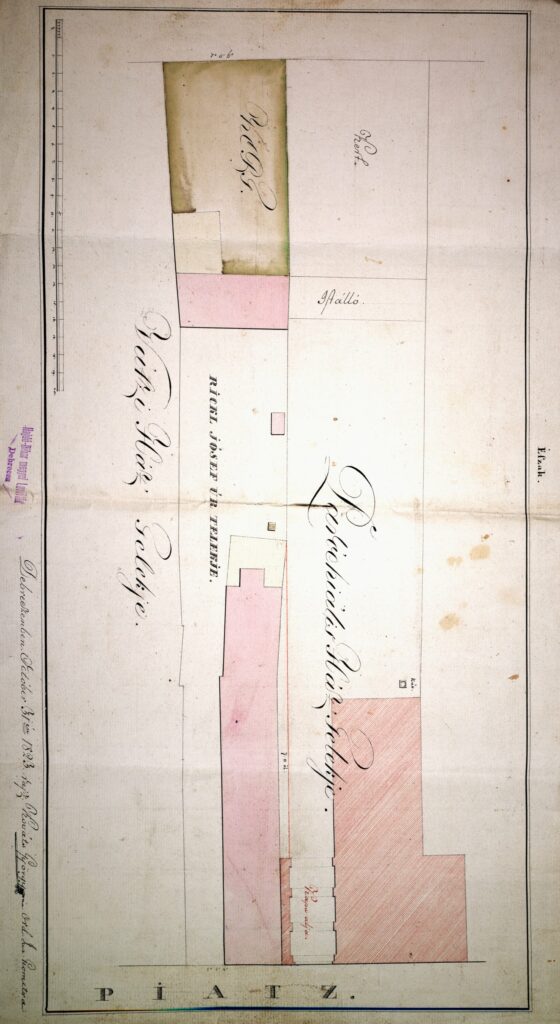
Plot drawing of 39 Piac street
Forrás: HU MNL HBVL XV 1b dvt-1034
Source: HU MNL HBVL XV 1b dvt-1034
„A magyarországi vevők a külföldi árúkból főként a fűszereket, ruhaneműeket, divatcikkeket, a norinbergi [nürnbergi] portékát keresték. A külföld kalmárjai a különféle lábasjószágon kívül leginkább a gyapjút, tollat (melyben a Rickl-üzlet szintén első volt), bőrt, gubicsot. hamuzsírt, szalonnát, stb. vásárolták.”
Móricz Pál: Magyar sirató. Feljegyzések, történetek a régi magyar életből. Szerző saját kiadása, Tahitótfalusi Sylvester nyomdai műintézet nyomásában, é.n.
“Of the foreign goods, Hungarian buyers were mainly looking for spices, clothes, fashion items, and goods from Nuremberg. The foreign merchants, in addition to the various kinds of livestock, bought mainly wool, feathers (in which the Rickl shop was also number one), leather, galls, potash, bacon, etc.”
Pál Móricz: Hungarian lament. Records, stories from the old Hungarian life. The author’s own edition, printed by the Sylvester Tahitótfalusi printing house, n.d.

Invoice issued to Sámuelné Boczkó dated 28 February 1902, on headed paper of József Rickl Zelmos’ shop To the Emperor of Turkey
Forrás: HU MNL HBVL XIII. 8. (Dragota család iratai)
Source: HU MNL HBVL XIII. 8. (Documents of the Dragota family)

The German-language certificate of József Rickl Zelmos about Ignácz Dragota’s internship. Dated 31 October 1825, Debrecen.
Forrás: HU MNL HBVL XIII. 8. (Dragota család iratai)
Source: HU MNL HBVL XIII. 8.b (Documents of the Dragota family)
„Velencei művű rézoroszlánfej kilincses tölgykapun át lehet bejutni ide, a nehéz tölgykapun az a ragyogó szép rézoroszlánfej már kívülről büszkén jelképezi az ősi nagykalmár gazdagságot, mely itten századokra berendezte biztonságos tűzhelyét.”
Móricz Pál: Magyar sirató. Feljegyzések, történetek a régi magyar életből. Szerző saját kiadása, Tahitótfalusi Sylvester nyomdai műintézet nyomásában, é.n. 11.
“The entrance is through an oak gate with a Venetian copper lion’s head handle, the heavy oak gate with its shining copper lion’s head proudly symbolises the ancient wealth of the great merchant, who established his safe hearth here for centuries”
Pál Móricz: Hungarian lament. Records, stories from the old Hungarian life. The author’s own edition, printed by the Sylvester Tahitótfalusi printing house, n.d. 11

The lion gate of the Rickl House
Forrás: Gerő László, 1951.
Source: László Gerő, 1951.
BELSŐ TABLÓ
INTERNAL TABLEAU
„Zelmos úr sokat küzdött, fáradozott egész életében. Nappalt, éjjelt kihasznált üzlete felvirágoztatására. A jövő-menő vásárosok éjjel is felzavarták pihenéséből a tekintélyes kalmárcsaládot.”
Móricz Pál: Magyar sirató. Feljegyzések, történetek a régi magyar életből. Szerző saját kiadása, Tahitótfalusi Sylvester nyomdai műintézet nyomásában, é.n. 13–14.
„Mr Zelmos has struggled and laboured all his life. He used the day and night to make his business flourish. The coming and going traders disturbed the rest of the respectable merchant family even at night.”
Pál Móricz: Hungarian lament. Records, stories from the old Hungarian life. The author’s own edition, printed by the Sylvester Tahitótfalusi printing house, n.d. 13–14
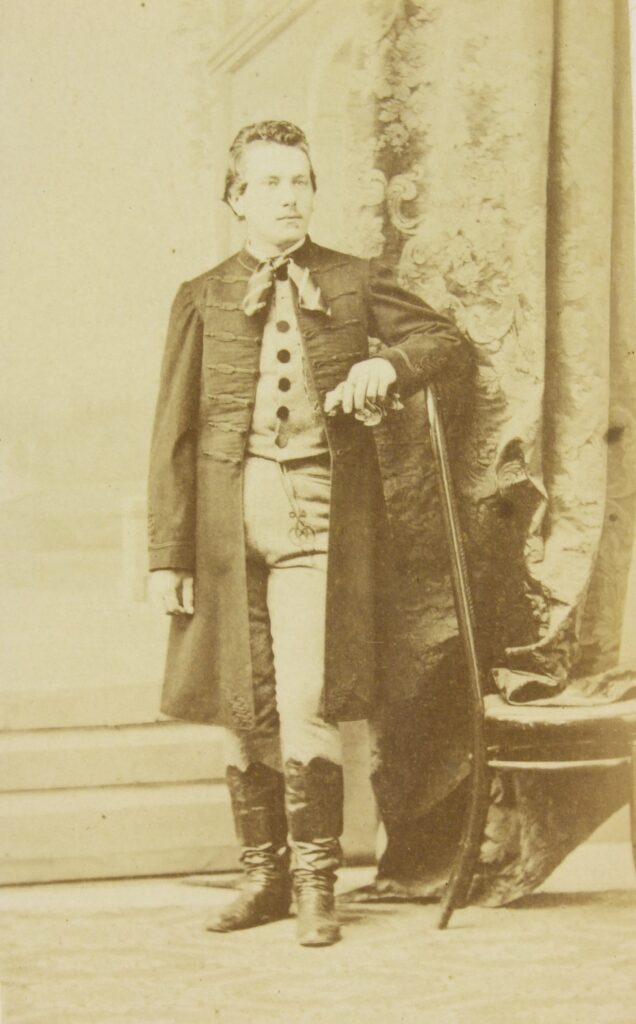
József Zelmos Rickl II (1818–1876). Grandson of the shop founder Rickl, who, according to the family legend, was the man with whom Sándor Petőfi swapped his sword. He continued to increase the shop’s turnover and the number of branches. He supported the creation of the Debrecen Music Academy with a considerable amount of money.
Gondy-Egey fényképészműhely, 1865.
Gondy-Egey photographical studio, 1865
„Antal, aki ügyvédi oklevéllel ment gazdálkodni az Elepre. Különösen szenvedélyes agarász volt, barátaival némelykor hetekig hajtotta a szilaj nyulat, 1848-ban meg, mint verespántlikás lovas főhadnagy, Arad-Lippa tájékán vitézkedett.”
Móricz Pál: Magyar sirató. Feljegyzések, történetek a régi magyar életből. Szerző saját kiadása, Tahitótfalusi Sylvester nyomdai műintézet nyomásában, é.n. 18.
„Antal, who went to Elep to work as a farmer with a law degree. He was a particularly passionate sighthound owner, sometimes he and his friends spent weeks chasing wild hare, and in 1848 he was fighting as a Red Ribbon Lieutenant on horseback in the Arad-Lipova region.”
Pál Móricz: Hungarian lament. Records, stories from the old Hungarian life. The author’s own edition, printed by the Sylvester Tahitótfalusi printing house, n.d. 18
„Antal bátyja, a nagykalmár Zelmos szintén lovas nemzetőr főhadnagy volt, Petőfi Sándor 1848–1849 telén, debreceni időzésekor, a Rickl-család emeletes házában sok kedves órát eltöltött.”
Móricz Pál: Magyar sirató. Feljegyzések, történetek a régi magyar életből. Szerző saját kiadása, Tahitótfalusi Sylvester nyomdai műintézet nyomásában, é.n. 18.
“Antal’s brother, Zelmos, also a cavalry lieutenant of the national guard, Sándor Petőfi spent many pleasant hours in the storied house of the Rickl family in Debrecen during the winter of 1848–1849.”
Pál Móricz: Hungarian lament. Records, stories from the old Hungarian life. The author’s own edition, printed by the Sylvester Tahitótfalusi printing house, n.d. 18

Antal Vilmos Rickl (1826–1861). Brother of József Zelmos Rickl II, lieutenant of the Red Ribbon Volunteer Cavalry Regiment in Debrecen, later first lieutenant, one of the wounded heroes of the battles around Arad and Lipova. Thanks to his marriage (he married the daughter of the Kis-Orbán family), the Rickl family became related to Debrecen’s political elite.
Orlay Petrich Soma festménye, 1854.
Painting of Soma Orlay Petrich, 1854
„A Rickl-család nehéz ezüsttel terített asztalánál a főzelékre pecsenye helyett havonként többször „bundáskenyér”, vagy „rántott-zsemlye” került. A vidám kedvű segédek után, akik mindnyájan úri-családok válogatott fiai voltak, a tojásba mártott, kirántott kenyeret nemsokára a családban, sőt városszerte „Rickli-pecsenye” néven nevezték.”
Móricz Pál: Magyar sirató. Feljegyzések, történetek a régi magyar életből. Szerző saját kiadása, Tahitótfalusi Sylvester nyomdai műintézet nyomásában, é.n. 21.
“At the table of the Rickl family, which was set with heavy silverware, the vegetable stew was topped with “French toast” or “fried rolls” instead of roast several times a month. After the cheerful attendants, who were all chosen sons of noble families, the bread, dipped in eggs and fried, was soon known in the family, and even throughout the town as the “Rickl-roast.”
Pál Móricz: Hungarian lament. Records, stories from the old Hungarian life. The author’s own edition, printed by the Sylvester Tahitótfalusi printing house, n.d. 21
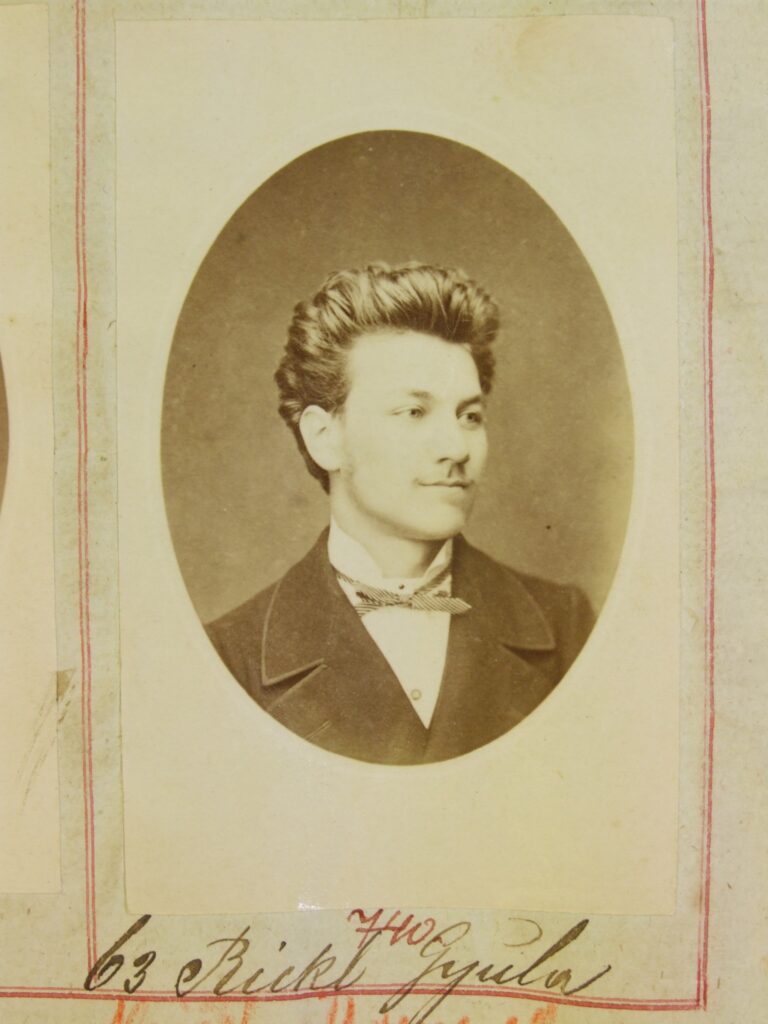

Gyula Rickl (1851–1922). Son of Antal Vilmos Rickl. After his university studies he was employed at the Hungarian Royal Ministry of Justice as a ministerial advisor. Later, as State Secretary for Justice, he became the Chief Inspector of Hungarian prisons. In 1896 he was given a noble rank by Franz Joseph with the first name Bellyei. He was also one of the founders of the Debrecen Hunting Society.
Gondy-Egey fényképészműhely
Gondy-Egey photographical studio
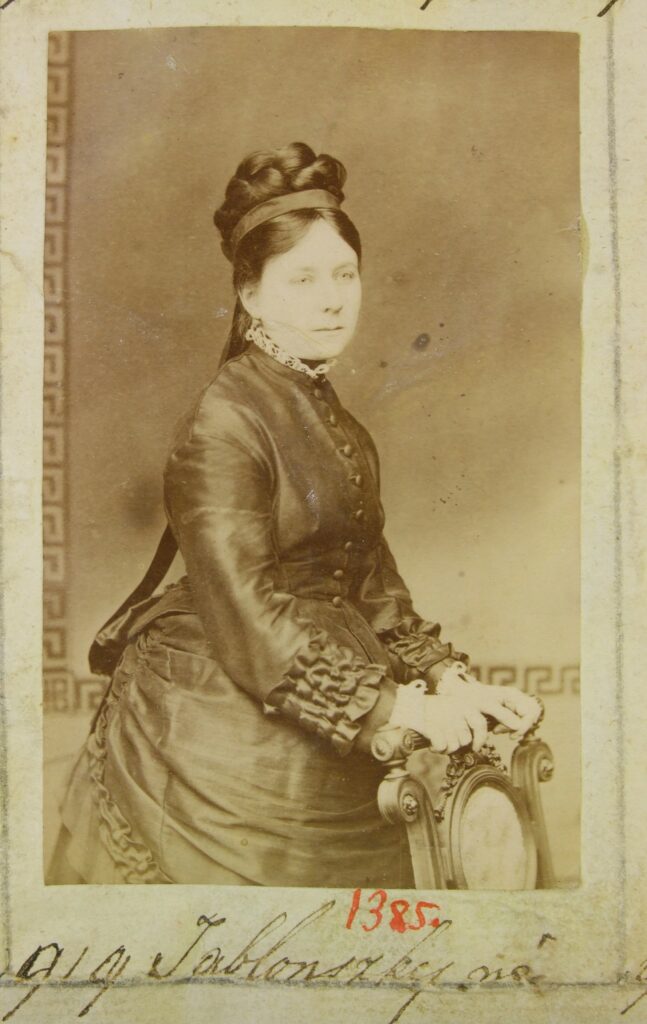
Mária Rickl Kálmánné Jakoblanczy (1842–1915). Daughter of József Zelmos Rickl II, grandmother of Magda Szabó, one of the protagonists of the author’s novel Régimódi történet [Old Fashioned Story]. Her husband was a landowner, and she had a reputation of being a proud rich merchant girl and a stern woman.
Gondy-Egey fényképészműhely, 1875.
Gondy-Egey photographical studio, 1875

Géza Rickl (1861–1915). Youngest child of József Zelmos Rickl II, he was the last owner of To the Emperor of Turkey, which closed on 1 September 1913. Instead of trading, he was more interested in farming, and was considered one of the greatest landowners in Debrecen.
Gondy-Egey fényképészműhely, 1881.
Gondy-Egey photographical studio, 1881
„A jóltájékozott Rozina nagyasszony, üvegfallal elrekesztett irodájából, a földesúri családok kedves tervezgetéseihez nem egyszer fűzött helyénvaló, jólirányító okos szót. […] Óriási fekete bőrkarosszékből osztogatta parancsait és az – igazságot.”
Móricz Pál: Magyar sirató. Feljegyzések, történetek a régi magyar életből. Szerző saját kiadása, Tahitótfalusi Sylvester nyomdai műintézet nyomásában, é.n. 15.
“The well-informed Grand Dame Rozina, from her glass-walled office, more than once added a word of appropriate, well-directed wisdom to the kind plannings of landowning families. From a huge black leather armchair, she dispensed her orders and – justice.”
Pál Móricz: Hungarian lament. Records, stories from the old Hungarian life. The author’s own edition, printed by the Sylvester Tahitótfalusi printing house, n.d. 15
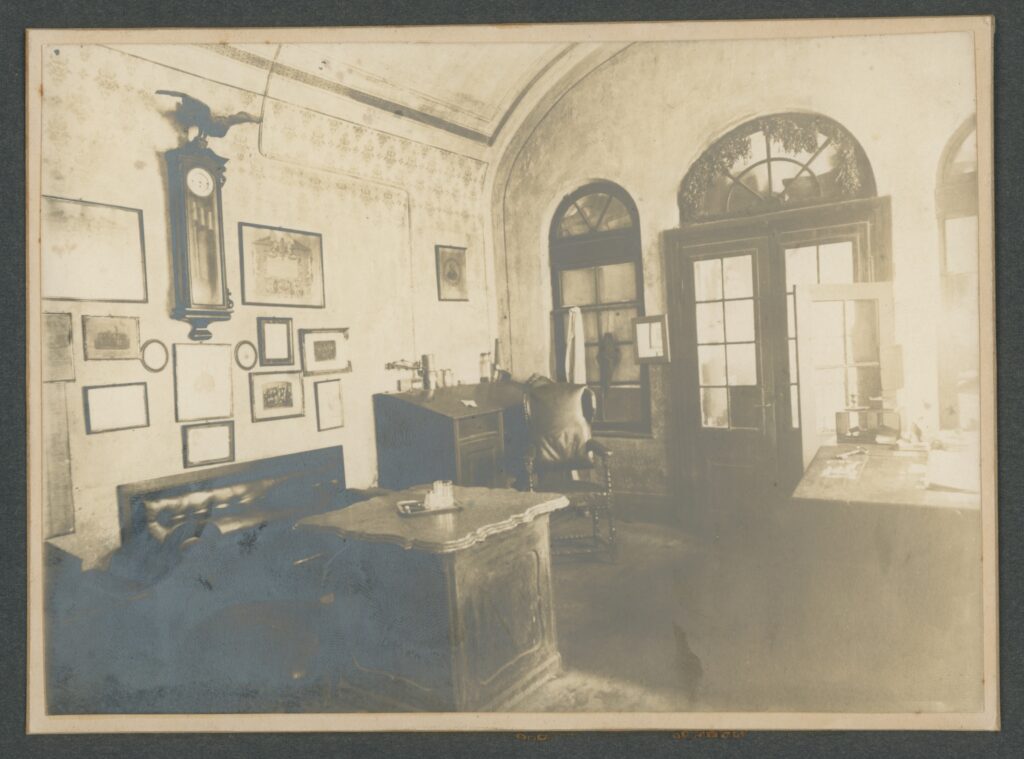
Office space of József Zelmos Rickl’s shop addressed To the Emperor of Turkey in the year of its closure.
Ismeretlen fényképész, 1913.
Unknown photographer, 1913
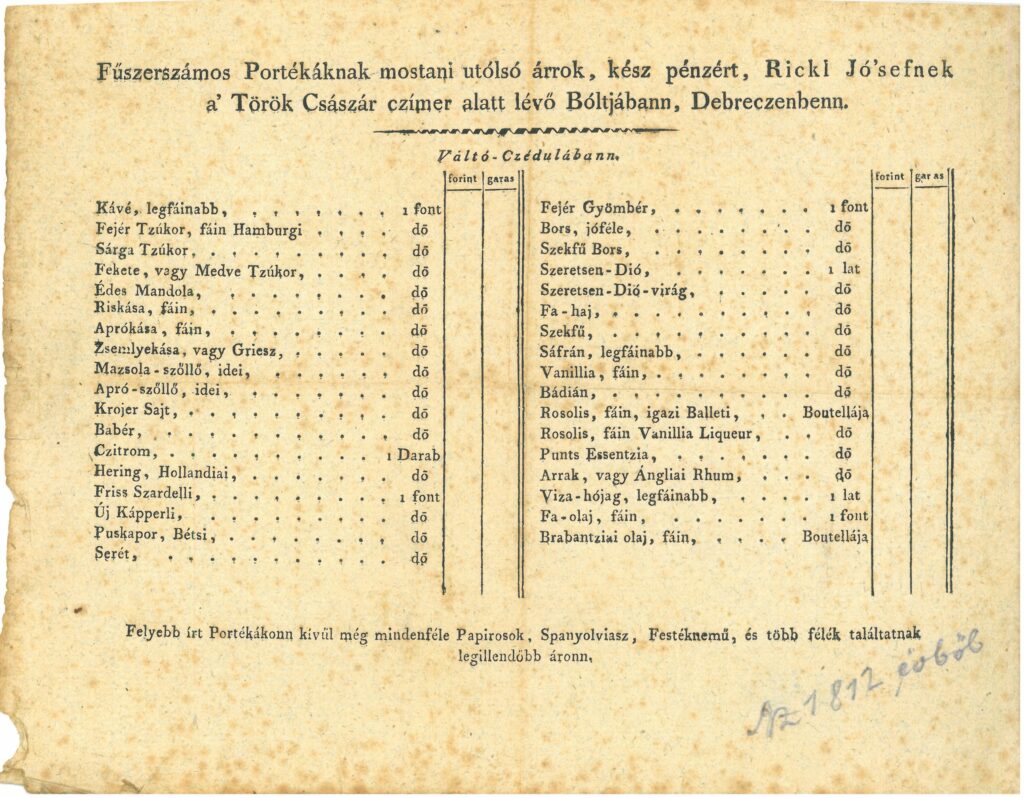
Price list of “spice products” from 1812.

Borító.
The purchase book of Ignácz Dragota from the year 1894 in the spice, fabric, dye and produce shop of József Zelmos Rickl.
Cover page

Belív.
The purchase book of Ignácz Dragota from the year 1894 in the spice, fabric, dye and produce shop of József Zelmos Rickl.
Inside page
A kiállításban közreműködtek/ Contributors to the exhibition:
Bacsa Balázs Antal, Dallos-Nagy Krisztina, Farkas Csaba, Kerekes Sándor, Lukács Tihamér, Novák Ádám, Orbázi Zoltán, Szabó Anna Viola, Szabóné Kovács Anikó, Szűcsné Molnár Márta, Tóth Róbert, Váradi Katalin
A kiállításban szereplő fotók és dokumentumok forrásai/ Sources of the photographs and documents featured in the exhibition:
Déri Múzeum, Magyar Nemzeti Levéltár Hajdú-Bihar Vármegyei Levéltára/ Déri Museum, Hajdú-Bihar County Archives of the Hungarian National Archives


0 hozzászólás